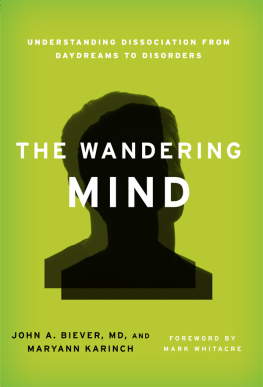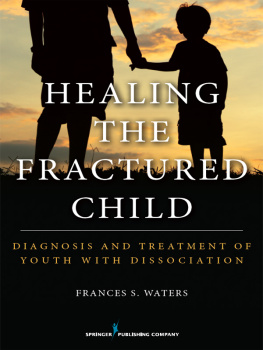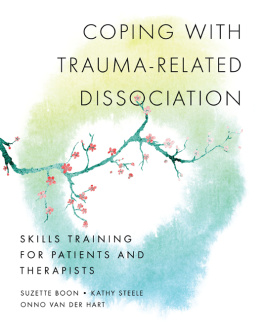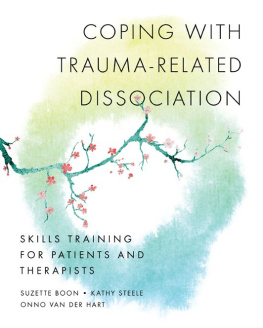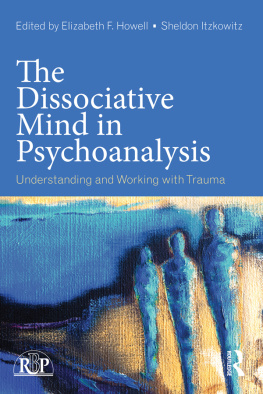Marlene Steinberg, M.D.
Maxine Schnall
T HERE ARE SOME things you learn in medical school that you spend the rest of your life unlearning. My adventure in this eye-opening process of discovery began in 1981, when I was a first-year intern in psychiatry at Jacobi Hospital, an affiliate of the Albert Einstein School of Medicine in New York City. At that time dissociationby which I mean a state of fragmented consciousness involving amnesia, a sense of unreality, and feelings of being disconnected from oneself or ones environmentwas a relatively new concept. As an emerging field, it was largely an unmapped territory, remote, fascinating, exotic, and considered to be off limits for all but the most intrepid explorers. We had yet to establish that dissociation, as part of our standard response to trauma, is a near-universal reaction to a life-threatening event and that mild or moderate experiences of dissociation are as common in otherwise normal people as anxiety and depression.
Furthermore, we thought that dissociative disorders were exceedingly rare, as many still mistakenly do today. The only cases that caught anyones eye were the most extreme forms of the severest dissociative disorder, then called multiple personality disorder, now known as dissociative identity disorder, or DID. It was assumed that every multiple behaved like the sensationalized heroines of Sybil or The Three Faces of Eve, floridly switching among dozens of separate personalities inside them. We had no idea that this dramatic switching is atypical and that multiples typically behave with far more subtlety and control, using compensatory techniques that make them indistinguishable in public from the figurative neighbor next door.
Unfortunately, this myth of the multiple as a freak of nature persists even today. It certainly prevailed in the early eighties, when I was an intern at Jacobi Hospital, and our introduction to a DID case had all the high drama and voyeuristic thrill of a theatrical event. Jacobi was an urban referral center for a very large mental health catchment area in the Bronx, serving an inner-city population of working-class people who were too poor to afford insurance. The psychiatric ER was a drab warren of interview cubicles and a crowded, noisy waiting room. Police officers were constantly bringing in belligerent, disoriented, or intoxicated drug users or alcoholics who needed to be restrained and were often handcuffed to chairs.
As part of our training, my fellow interns and I made rounds with a psychologist who was a senior member of the faculty at Einstein and wanted us to observe an inpatient he suspected had multiple personality disorder. The first day we were simply to meet Gloria, and the next day we were to watch if alternate personalities emerged. We were told that this would be a unique experience since Glorias condition was so rare that we would probably never encounter more than one or two such cases in a lifetime of practice.
When we first saw Gloria, a Hispanic woman in her early thirties with caffe lattecolored skin and a mass of curly dark hair framing her thin face, she seemed depressed and anxious but not remarkable in any discernible way. She conversed intelligently as a mature woman, revealing that she was a single mother supporting three children with part-time work as an office clerk. Her erratic behavior involving speaking like a child and slashing her wrists after a fight with her boyfriend caused her to be hospitalized.
The following day, when we went back to see Gloria, she was hooked up to an IV through which sodium amobarbital (Amytal) was being infused. Amytal is a barbiturate that has a sedating effect and lowers inhibitions. The idea was to relax Gloria sufficiently so that her guard would lower and her alternate personalitiesif they existedwould emerge, thereby confirming the suspected diagnosis.
We watched, wide-eyed, as the Amytal worked with startling efficiency. In a matter of minutes Gloria switched to a tearful adolescent alter she called Carmelita, sadly complaining in a high, girlish voice about the hopelessness and oppressiveness of her life. This weeping teenager, tossing her hair back from her face and wringing her hands, was a completely different person from the woman we had met the day before. Suddenly Gloria switched again. This time she regressed into a more childlike state, CeeCee, and began babbling in baby talk about bad booboos that Mommy and Daddy did, and about her mothers yanking her ponytail and part of her ear out of her head and making her jump from one rooftop of a building to another to escape her drunken father, who was chasing them with a drawn fishing knife. All the while she was wailing and pounding her fists on the bed in fear and rage. Then, in the blink of an eye, we heard, Can I talk to you? Its me, Laura, as another alter spoke up in a polite, reasonable tone. I think it was unfortunate that we needed CeeCee to bear the brunt of all of that crazy stuff that everybody said was a lie, but somebody has to carry all of it inside; otherwise were going to go crazy.
When we left Glorias room, I came away shaken by what I had seen. I wanted to learn what the course of treatment for her would be. When I inquired about her later, I was told that she fled the hospital the next day after the Amytal had induced her alters to surface before a group of gawking residents. I could understand why. How frightened, embarrassed, and humiliated she must have been. Regret for the insensitivity shed suffered under the rubric of training turned this unfortunate event into a defining moment for me.
It was obvious that presenting Gloria to us like a dancing bear who could produce alters on demand was of no therapeutic value to the patient. Surely she would have preferred being in control of her personality states herself. What need was there to induce them by using drugs without treating these personalities once they were out? I vowed that this would not be the diagnostic method of choice for me if I ever came across a multiple again. Given the opportunity, I would work with such a person gently, helping her to learn about the different parts of herself and to feel comfortable with them so that she could talk about them openly and eventually accept and unify them. That opportunity seemed only a remote possibility.
I left Jacobi at the end of my internship and went to Yale in 1982 to finish my residency. During my first year at Yale my clinical supervisor, Francine Howland, M.D., introduced me to the treatment of dissociative symptoms and disorders. She was one of a tiny minority of professionals who gave such work any credence. Having been previously told how rare multiples were, I was astonished to identify three people that year who exhibited all of the symptoms of multiple personality disorder, now called dissociative identity disorder or DID. I wondered why I, a junior resident, was encountering so many of these cases whereas more experienced clinicians rarely did. Others questioned my diagnoses, provoking electrifying controversy about them, but the symptoms were irrefutably present.






